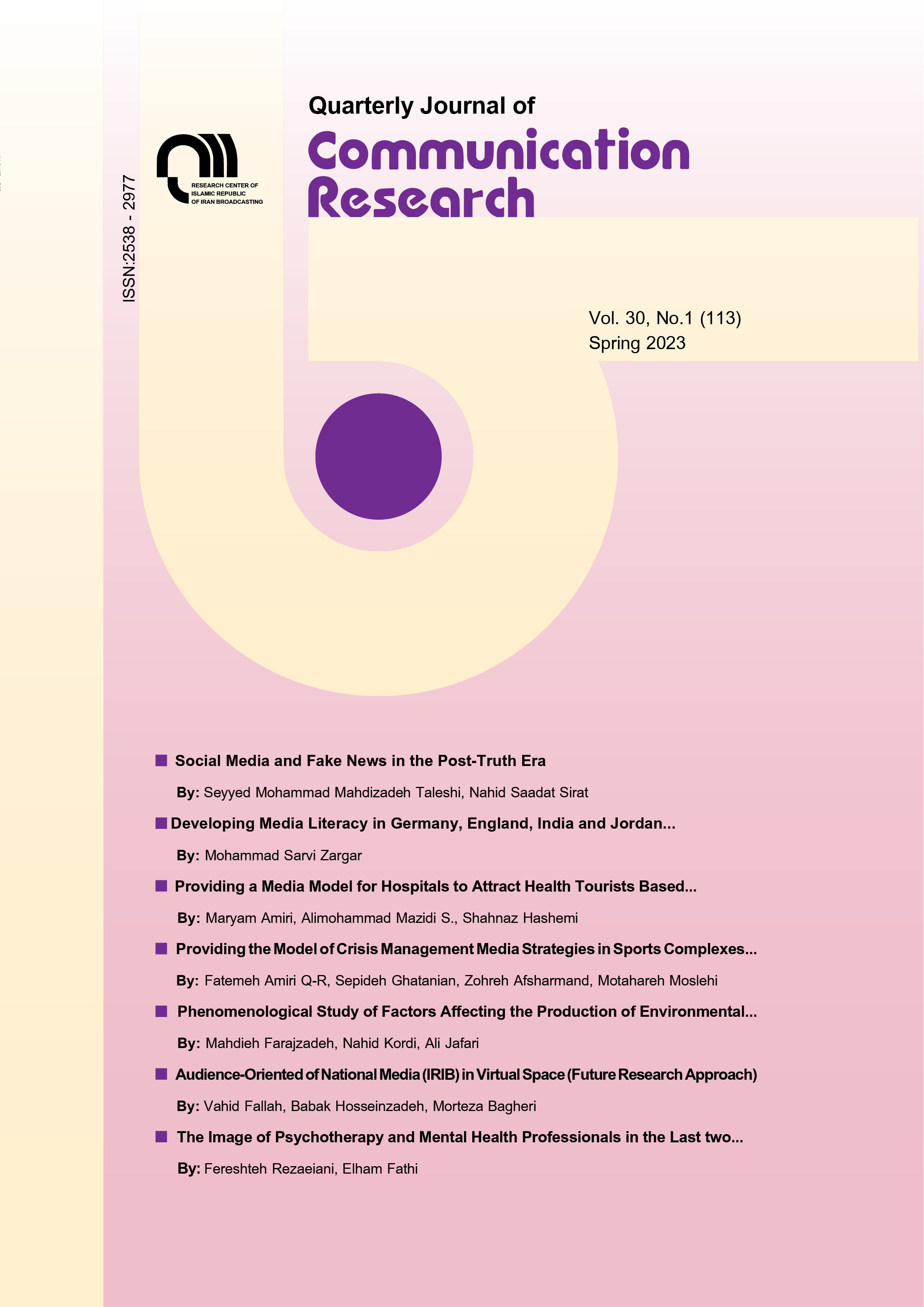Ahmadi, F. Et Al. (2008). Delphi Technique: A Tool In Research. Journal Of Education In Medical Sciences, 8 (1).
Akbari Azad, M. Et Al. (2009). Examining Pod Casting’s Opportunities And Threats For Radio In Iran In Communications Experts, View. Journal Of Communication Research, 16 (59).
Akbarzadeh, A. Et Al. (2018). An Audience-Centric Approach In Dealing With Virtual Social Networks. Media And Culture Journal, 8 (2), 1-18.
Akhlaghipour, M. & Golbakhshi, H. (2013). Measuring The Size Of IRIB’s Internet Audience And Its Related Capacities A Case Study Of Bandar Abbas’ Residents. Journal Of Communication Research, 20 (4), 9-35.
Aliaskari, A.; Salavatiyan, S. & Alborzi Davati, H. (2014). Developing Possible And Preferable Futures For National Media (IRIB) In The Internet. Journal Of Communication Research, 21 (77), 69-96.
Alizadeh, A. R. (2006). Conducting Research Using The Delphi Method. Tehran: Yousefi Pub.
Bagheri, A. & Zareian Jahormi, F. (2012). The Relationship Between Virtual Space And Religious And National Identity (Case: Yasouj University Students). Journal Of Strategic Studies, 16(60), 149-182.
Farhangi, A. A. & Abtahi, A. (2013). The Future Of Media Management & The Management Of Future Media. Jopurnal Of Future Studies Management, 2 (1), 83-107.
Gill, D. & Adams, B. (2005). ABC Of Communication Studies (Karimian, R.; Mohajer, M. & Nabavi, M. Trans.). Tehran: Bureau Of Media Studies And Planning Pub. (Original Work Published 2002).
Hashemi, Sh.; Dindar Farkoosh, F. & Marvili Ahmadi, L. (2011). Conceptual Model Of The Use Of Internet Space By The Audience. Journal Of Media Studies, 6 (13), 215-193.
Khajeheian, D.; Farhangi, A. A. & Hadaviniya, A. (2009). Designing Interactive Model Of Media Management Using Modern Information And Communication Technologies. Journal Of Communication Research, 16 (6), 11-66.
Labafi, S. (2014). Presenting The News Policy Model In The Islamic Republic Of Iran. (Doctoral Thesis). Faculty Of Management, University Of Tehran.
Labafi, S. Et Al. (2016). Examining The Role Of Social Networks In Marketing Using Taylor And Okazaki's Framework. Journal Of Media Studies, 12(3), 103-114.
Mahdizadeh, S. M. (2011). Media Theories: Common Ideas And Critical Views. Tehran: Hamshahri Pub.
Mcquail, D. (2007). Mass Communication Theory: An Introduction (Ejlali, P. Trans.). Tehran: Bureau Of Media Studies And Planning. (Original Work Published 1984).
Mehrdad, H. (2002). Introduction To Mass Media Concepts And Theories. Tehran: Institute Of Faran.
Mohsenian Rad, M. (2008). Pathology Of Audience Perception, In The Field Of Media, Globalization And The Era After The Global Village. Journal Of Cultural Research Of Iran, 1(3), 113-79.
Momeni, M. (2006). New Topics Of Research In Operations. First Edition, Tehran: Tehran University Pub.
Pakdel, H. Et Al. (2020). Explanation Of IRIB Challenges In Cyberspaces (Compiling Suitable Strategies For IRIB’s Deputy Of Cyberspaces). Journal Of Interdiciplanary Studies In Media And Culture, 3 (1), 11-35.
Postman, N. (2007). Amusing Ourselves To Death: Public Discourse In The Age Of Show Business (Tabatabaei, S. Trans.). Tehran: Ettelaat Pub. (Original Work Published 2005).
Rezaeian Ghiebashi, A. & Bayati, L. (2018). Scenarios Of The Presence And Activity Of IRIB In Media Perspective Document 1407 (Case: Jahaanbin Broadcasting - Chaharmahal Va Bakhtiari Province). Journal Od Communication Research, 25 (96).
Roshandel Arbatani, Tahir Et Al. (2014). Designing And Explaining The News Policy Model Based On The Fundamental Components In The Radio And Television Of The Islamic Republic Of Iran. Journal Of Public Management Research, 8 (28), 109-137.
Sarukhani, B. & Nowrozi, A. (2013). Factors Affecting Audience Persuasion In Virtual Space. Journal Of Society-Culture-Media, 1(12), 1-11.
Severin, W. & Tankard, J.W. (2006). Communication Theories (Dehghan, A.R. Trans.). Tehran: Tehran Uni. (Original Work Published 1979).
Sharifi, S. M. Et Al. (2019). Presenting News Management Model For Iran’s National Broadcaster In Cyberspaces With An Approach Of Ritual Communication. Journal Of Interdisciplinary Studies In Communication & Media, 2 (4), 11-30.
Talibpour, A. Et Al. (2013). Reviewing And Categorizing The Strategy Of The Countries Of The World In Facing Virtual Social Networks. Strategy, 23(73), 43-71.
Tavallaei, R. (2013). The Future Research Of Iran's Cyberspace Services In The Process Of Technological Globalization. Journal Of Strategic Studies Of Public Policymaking (Strategic Studies Of Globalization), 5 (14), 92-123.

